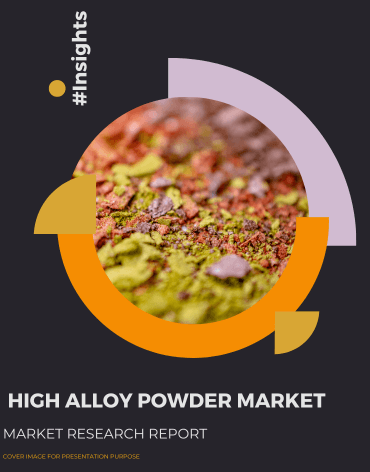High Alloy Powder Demand Estimated to Reach USD 2.12 Billion by 2029

High alloy powders have been in use for several decades, and their development and application have evolved over time. The use of high alloy powders began to gain prominence in the mid-20th century, driven by advancements in metallurgy and materials science. However, it's essential to note that the term "high alloy powder" is a broad category encompassing various metal powders with a high proportion of alloying elements.
The high alloy powder industry produces and applies metal powders that contain a high proportion of alloying elements. These alloy powders are used in various industrial applications due to their unique properties and characteristics.
1 . High Alloy Powder Examples
Nickel Alloy Powder: Nickel alloys are created by adding nickel to other metals or elements to enhance their properties. Nickel alloy powders are known for their excellent corrosion resistance, high-temperature strength, and thermal stability. These alloys often contain elements like chromium, molybdenum, and iron, which provide specific properties suited to various applications.
Cobalt Alloy Powder: Cobalt alloys mainly comprise cobalt and other elements like chromium, tungsten, and nickel. Cobalt alloy powders exhibit high wear resistance, excellent strength at elevated temperatures, and good corrosion resistance. These properties make them suitable for applications in harsh environments like aerospace, oil and gas, and medical industries.
Aluminum Alloy Powder: Aluminium alloys are lightweight and have excellent mechanical properties. They are often combined with other elements like copper, magnesium, or zinc to enhance their strength and hardness further. Aluminum alloy powders find applications in the automotive, aerospace, and construction industries due to their lightweight and corrosion-resistant nature.
Titanium Alloy Powder: Titanium alloys are known for their high strength-to-weight ratio, excellent corrosion resistance, and biocompatibility. They find applications in aerospace components, medical implants, and high-performance sports equipment.
Other examples are Cobalt-Chrome Alloy Powder, Stainless Steel Powder, Tungsten Alloy Powder, Molybdenum Alloy Powder, Copper Alloy Powder, Superalloy Powder, and Bronze and Brass Powder.
2 . High Alloy Powder Market
- The Global High Alloy Powder estimated at US$ 1,277.99 million in the year 2023, is projected to reach a revised size of US$ 2,119.62 million by 2029, growing at a CAGR of 7.41% during the forecast period 2023-2029.
- The US & Canada market for High Alloy Powder is estimated to increase from $ 501.54 million in 2023 to reach $ 806.3 million by 2029, at a CAGR of 8.23 % during the forecast period of 2023 through 2029.
- The China market for High Alloy Powder is estimated to increase from $ 308.69 million in 2023 to reach $ 506.8 million by 2029, at a CAGR of 8.61 % during the forecast period of 2023 through 2029.
- The Europe market for High Alloy Powder is estimated to increase from $ 327.19 million in 2023 to reach $ 475.43 million by 2029, at a CAGR of 6.43% during the forecast period of 2023 through 2029.
3 . High Alloy Powder Manufacturing
High alloy powder manufacturing involves the production of metal powders that contain a high proportion of alloying elements. These metal powders are used in various industries for their specific properties, such as high strength, corrosion resistance, and thermal stability. The manufacturing process typically involves the following steps:
Raw Material Selection: The first step is to select the appropriate raw materials for alloy powder production. These materials could be pure metals, metal ores, or other compounds containing the desired elements in the alloy.
Melting and Alloying: The selected raw materials are melted in a high-temperature furnace. Alloying elements are added in precise proportions to achieve the desired composition of the alloy. This step is critical in determining the final properties of the alloy powder.
Atomization: Once the alloy has been melted and mixed thoroughly, it is subjected to atomization. Atomization involves breaking the molten metal into small droplets using various methods, such as gas atomization, water atomization, or centrifugal atomization. This process forms fine metal droplets that solidify into powder as they cool down rapidly.
Cooling and Solidification: The atomized metal droplets are collected and rapidly cooled to solidify them into fine metal powders. The cooling process is crucial as it affects the microstructure and properties of the final powder.
Sizing and Classification: The resulting alloy powders may have a wide range of particle sizes. The powders are subjected to sieving and classification processes to achieve the desired particle size distribution. This step ensures that the powder meets the specific requirements of various applications.
Post-Treatment: Depending on the application, the alloy powders may undergo post-treatment processes to enhance their properties further. These treatments can include heat treatment, surface coating, or alloy modification to tailor the powder's characteristics for specific uses.
Quality Control: Quality control measures are implemented throughout manufacturing to ensure that the alloy powders meet the required standards and specifications. Quality checks may include particle size analysis, chemical composition verification, and performance testing.
Packaging and Storage: Once the alloy powders meet the desired quality criteria, they are packaged in suitable containers to prevent contamination and maintain their properties during storage and transportation.
The high alloy powder manufacturing process requires precise control over the final powders' composition, particle size, and microstructure. These powders serve as crucial materials for various industries, including aerospace, automotive, medical, and electronics, where the unique properties of high alloy powders are utilized to create advanced components and products.
4 . High Alloy Powders Demand
High alloy powders are in demand across various industries due to their exceptional properties and performance advantages. Some of the key needs for high alloy powders include:
Advanced Manufacturing: High alloy powders are vital in advanced manufacturing processes like additive manufacturing (3D printing), metal injection molding (MIM), and thermal spray coating. These processes rely on the unique properties of high alloy powders to create complex, high-performance components with superior mechanical, thermal, and chemical characteristics.
Aerospace and Defense: The aerospace and defense industries require high alloy powders for critical components, such as turbine blades, engine parts, and structural elements. These powders' high strength, corrosion resistance, and temperature stability make them suitable for use in extreme conditions.
Medical and Healthcare: High alloy powders are used in medical devices and implants due to their biocompatibility and corrosion resistance. Titanium and cobalt-chrome alloys are commonly used in orthopedic implants and dental applications.
Automotive Industry: The automotive industry utilizes high alloy powders for lightweight and high-strength components, improving fuel efficiency and better performance. These powders are used in engine parts, transmission components, and suspension systems.
Oil and Gas: High alloy powders are crucial for oil and gas exploration and production equipment. They provide excellent resistance to corrosion and wear, making them suitable for pumps, valves, and drilling tools.
Electronics and Electrical Industry: High alloy powders are used in the electronics and electrical sectors for their thermal conductivity and electrical properties. They are employed in components like heat sinks, connectors, and electrical contacts.
Chemical Processing: High alloy powders find applications in chemical processing equipment where resistance to corrosion and high temperatures is essential. They are used in reactors, pipes, and vessels handling corrosive substances.
Renewable Energy: High alloy powders are utilized in renewable energy technologies such as wind turbines and solar power systems. They provide the necessary strength and corrosion resistance for critical components in these systems.
Mining and Construction: The mining and construction industries use high alloy powders for wear-resistant components like cutting tools, drilling equipment, and crusher parts, which can withstand harsh conditions.
Environmental Protection: High alloy powders are used in pollution control devices like catalytic converters in automotive exhaust systems. These alloys facilitate chemical reactions that help reduce harmful emissions.
5 . High Alloy Powder Market Trends
Additive Manufacturing (3D Printing): Additive manufacturing continues to drive demand for high alloy powders. As industries increasingly adopt 3D printing for rapid prototyping and the production of complex components, there is a growing need for high-performance alloys like nickel, cobalt, and titanium-based powders. These powders offer superior mechanical properties, corrosion resistance, and high-temperature performance, making them ideal for aerospace, medical, and automotive applications.
Advancements in Powder Atomization: Atomization is critical in producing metal powders. Recent trends have focused on improving atomization techniques to produce powders with better flowability, narrower particle size distribution, and improved consistency. Innovations in gas atomization, water atomization, and other atomization methods aim to enhance powder properties and lower manufacturing costs.
Customization and Alloy Development: Industries are seeking more specialized high alloy powders tailored to their specific requirements. Manufacturers are investing in research and development to create new alloy compositions and optimize existing ones to meet the demanding needs of various applications. Customized alloys with unique combinations of elements are becoming more prevalent to address specific challenges.
Sustainability and Recycling: Environmental concerns drive the industry's interest in sustainable practices. Efforts are being made to develop recycling processes for high alloy powders, reducing waste and conserving resources. Recycling scrap materials and used components can help minimize the environmental impact of the high alloy powder industry.
Emerging Applications: High alloy powders are finding new and innovative applications beyond traditional industries. For example, high-performance alloys are being explored for applications in renewable energy technologies, such as turbine components for wind energy, and in developing advanced batteries and fuel cells.
Digitalization and Industry 4.0: Integrating digital technologies and data-driven processes transform the high alloy powder industry. Automation, AI-driven quality control, and smart manufacturing techniques are being adopted to optimize production, reduce defects, and enhance overall efficiency.
Powder Consolidation Techniques: Powder consolidation methods, such as hot isostatic pressing (HIP) and spark plasma sintering (SPS), are being used to improve the mechanical properties of high alloy powders. These techniques help to densify the powders into fully dense, high-performance components with minimal grain growth.






